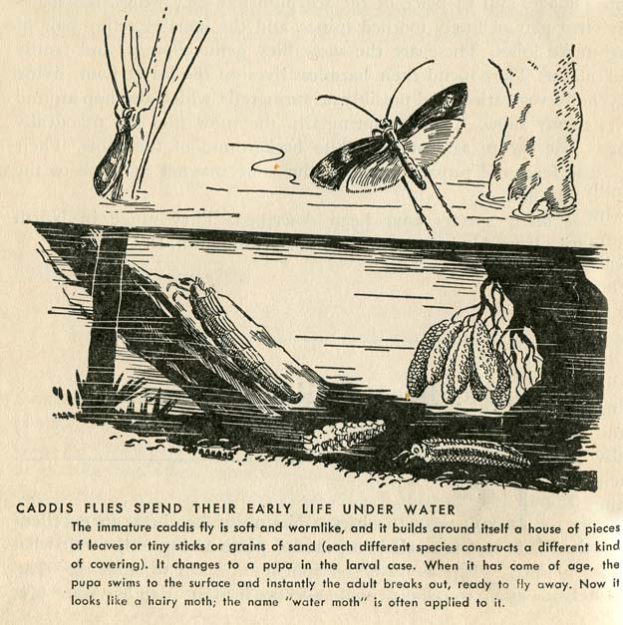Frederick Drimmer, The Animal Kingdom : The Strange and Wonderful Ways of Mammal, Birds, Reptiles, Fishes and Insects, vol. III, New York, greystone Press, 1954, pp. 1836-1837.
As you watch abstractedly, your mind records a movement. You concentrate on this spot of activity until you make out what appears to be a tiny cylinder of leaf particles slowly moving along the bottom. What makes it move ? As you wonder you discover a shining spot at one end of the cylinder. This shining spot its the head of a larva, with six tiny legs close behind all that is visible of a representative of one of the most interesting of the insects orders. The soft and succulent body of the caddis worm (the usual term for the caddis-fly larva) is safely protected in a snug home it has built of leaf fragments fastened with its own spun silk.

In the same pool, you will soon pick out other species of caddis-fly larvae, each identifiable by the type of house it builds. Some are lazy and simply cut off a hollow weed stem, into which the body snugly fits. When the creature outgrows its quarters, it moves to a slightly larger piece. All it adds to its prefabricated dwelling is a silken lining on the Inside walls.
Another species selects minute pieces of weeds ; that is, they are minute to us, but to the insect, they must appear like giant logs. Members of this species carefully fasten the weed pieces together into a cylindrical home. When they need more room, they simply slit open one side and insert a new log.
Still another species likes to crisscross its logs, building up a turret-shaped home. One wonders how the larva is able to drag this cumbersome house about ; the ends of the log stick out in all directions, catching on every obstacle. These are but a few example. In all quiet, somewhat muddy, debris-strewn pools, many kinds of caddis-worms houses ae dragging along their muddly paths.
Building houses with snails
Then there are stone masons among the caddis flies. To find these, we shall have to go to a sandy or gravelly pool. Here your eye, now trained to detect caddis-worm houses, will find a dozen styles to attract your attention ; Some creatures have built simple, hollow cylinders of very fine grains of sand. Others use small fravel, which to them must represent huge boulders. As they build, the caddis-worms may pick up minute snail shells, apparently mistaking them for gravel, and fit them into their stones houses.
Offen enough the snail is still living in its shell, but off it goes willy-nilly, as part of the caddis-worm castle. The snail reaches out for food or footshold but is usually too small to succeed. Given a big enough snail, however, and an opportunity for it to take hold some substantial objects, a true tug-of-war ensues. Sometimes the snail wins, and the caddis worms must find another nugget to fill the gap in its wall.